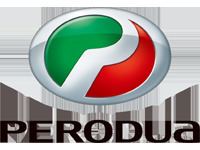Type Limited company Products Economy cars Founded 1993 | Website www.perodua.com.my Number of employees 10,000 | |
 | ||
CEO En Aminar Rashid Salleh (16 Nov 2009–) Profiles | ||
Perodua cars history perodua cars malaysia cars product
The Perusahaan Otomobil Kedua Sendirian Berhad (Second Automobile Manufacturer Private Limited), usually abbreviated to Perodua /pəˈrɒdjuːə/, is Malaysia's largest automobile manufacturer closely followed by Proton. It was established in 1992 and launched their first car, the Perodua Kancil in August 1994. 'M2' refers to the codename which was used when the project to establish Perodua was still top secret. The shareholders of Perodua are UMW Corporation Sdn Bhd with 38% stake, Toyota (25%), MBM Resources Bhd (20%), PNB Equity Resources Corporation Sdn Bhd (10%) and Mitsui & Co. Ltd (7%).
Contents
- Perodua cars history perodua cars malaysia cars product
- Domestic
- International
- Current products in production
- Former products in production
- Corporate slogan
- Anniversary slogan
- Logo
- References
Initially, Perodua mainly produces minicars and superminis and does not have models in the same market segments as Proton. In recent years, their targeted market segments have started to overlap. Especially in the supercompact segment where the Perodua Myvi has fought off the Proton Savvy and is now competing with the Proton Iriz
Perodua do not design or engineer their main components, such as engine and transmission, in house. Their cars have historically used Daihatsu component designs. Daihatsu held a 20% stake in Perodua at the company's launch, increasing this to 25% in 2001 and then to 35%. In 2004, Perodua started assembling the Toyota Avanza at their plant in Rawang, for sale in Malaysia.
Perodua sold over 207,100 vehicles in 2016, which was its highest ever sales record, and a highest ever market share of 35.7%. It is planning to set up a second car manufacturing plant from the planned $770 million investments in the coming years.
Domestic
Perodua expected to become the largest manufacturer of compact cars in South-East Asia. By October 2005, it had produced a cumulative total of 1 million cars. By July 2008, it expected to 240,000 per year.
As compared to Proton, Perodua has been quite successful in its business ventures. The automobile manufacturer is popular in Malaysia, with the Perodua Myvi having sold 80,327 units in 2006, outselling its rival's best selling car, the Proton Wira then, which sold only 28,886 units in Malaysia. In 2006–2010, Perodua was the best selling car company in Malaysia. In the first half of 2011, Proton instead overtook Perodua to be the best-selling brand that year. It was many years since the first national carmaker had been the best-selling and though part of the reason was that Perodua's supply in the second quarter was limited (due to phasing-out of the old Myvi) and also the problems caused by the amendments to the H-P Act, it was to be said that Proton's current line-up has drawn many customers, notably the core models Proton Saga and Proton Persona. Proton delivered 85,223 units to take a 28.7% share of the TIV while Perodua delivered 79,467 units, a difference of 5,756 units.
International
In the United Kingdom, their cars were sold by some Proton dealers who wish to attract customers seeking a smaller and cheaper alternative to the Proton range. Sales numbers in the UK were small, however, and in 2008 Perodua sold only 624 cars (down from 914 in 2002) and insignificant compared to 2008 figures of 28,036 for Hyundai, 29,397 for SEAT. Sales were up slightly in 2009 (to 650) and then to 761 in 2010, mainly due to the success of the new Perodua Myvi. Besides the UK and Singapore, Perodua also exports their cars to Mauritius, Brunei, Sri Lanka, Cyprus, Malta, Egypt, Nigeria, Senegal, Lebanon, Qatar, Saudi Arabia, Syria, Nepal, Fiji and the Republic of Ireland in small numbers by local dealers.
Current products in production
Former products in production
Corporate slogan
Anniversary slogan
Logo
Perodua organised a competition in 1997 to find a new corporate logo, to be launched together with their upcoming model, tentatively known as the X555. The competition was won by Johnson Ng Weng Kuan, an architecture student from Universiti Teknologi Malaysia. Perodua officially launched the new corporate logo on 24 August 1998 when they launched Malaysia's first 4x4 vehicle, the Perodua Kembara.
The new logo maintains the 'P' and '2' and the colours of the old, squarish logo, but has been stylised further to become elliptical, which is more fluid and dynamic. The green colour represents social responsibility to the environment and the community, while the red colour symbolises the development of a competent workforce and resilience in meeting challenges in the globalised world. However, the emblems mounted on the company's latest cars have black in place of the green and red areas, with the chrome relief maintained as it was.
